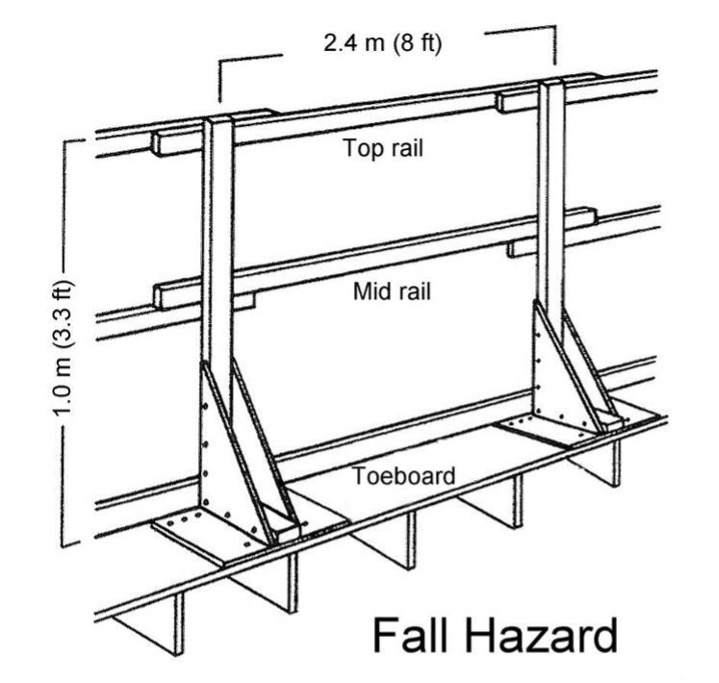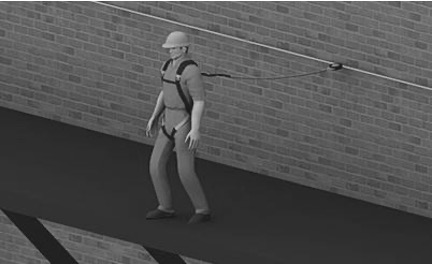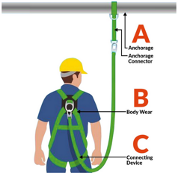6 Fall Restraint Systems
Guardrails
Guardrails provide a high degree of protection once installed properly. A guardrail must be designed and installed in compliance with the latest version of CSA standard CSA Z797: Code of Practice for Access Scaffolds.

- Posts, secured against movement, generally spaced at 2.4m o.c.
- Top Rail, 1.0 m ± 75 mm (39 in ± 3 in) to the top of the rail.
- Toe board, resting on the platform and extending up a min of 75 mm (3.5 in).
- Midrail, centered in between top rail and toe board.
- Must resist a 200 lb. force applied vertically or horizontally at any point.
- A self-closing gate, double-chain gate or similar device with a minimum 0.56 m (22 in) clear width opening that replaces the normal guardrailing when the point of access is located at the guardrail.
- Guardrail may be omitted at the edge of a platform where the gap between the wall and the platform does not exceed 0.3 m (12 in).
Temporary Flooring
- Cover entire work area,
- Be able to withstand four times the load likely to be imposed, and
- Be securely fastened in place
Travel Restraint Systems

- An active, personal travel restraint system stops a person from getting close enough to a location where they may fall.
- It utilizes a body belt or harness connected to an anchor point that will withstand a 1.8 kN (400 lb) load on a level surface. This load requirement increases with the slope.
Personal Fall Arrest Sysytems

An assembly of components that arrests a person’s fall when properly assembled, used together and connected to a suitable anchorage.
- Must ensure that arrest forces are limited to 8 kN (~1800 lbs).
- Must be used in accordance with manufacturers’ specifications.
Components include:
- Anchors
- Full body harnesses
Connecting components:
- Energy absorbers and lanyards
- Self-retracting devices
- Vertical lifelines and fall arrestors
Anchorage
Anchorage means a secure point of attachment for lifelines, lanyards or other deceleration devices. Anchors must be capable of withstanding:
- a force of 22 kN (5000 lbs), for a non-engineered anchorage;
- 2 times the maximum arresting force anticipated, for an engineered anchorage.
Consider the following when choosing a point to attach your personal fall arrest system:
- Identify suitable anchorage points. What you tie off to is the key to the whole system!
- Don’t “tie back” a regular lanyard. Passing lanyards or lifelines around “H” or “I” beams can reduce strength by 70%!
- Eye bolt strength is along the axis of the bolt (a straight pull). Don’t “shear” the bolt.
Full Body Harness
A full body harness is constructed of straps which may be secured about the wearer in a manner that will distribute the fall arrest forces over at least the thighs, pelvis, waist, chest and shoulders, with some means for attaching it to other components of a personal fall arrest system. The harness is a crucial element in limiting the arrest forces to a maximum of 8 kN (~1800 lbs).
Note: Body belts are never to be used as part of a fall arrest system. Body belts used for fall protection are only for work positioning or as a component in a travel restraint system that prevents a person from accessing an area where a fall may occur.
CSA Standard Z259.10, Full Body Harnesses[1]
- Group A – Fall Arrest
- Group D – Controlled Descent
- Group E – Limited Access
- Group L – Ladder Climbing
- Group P – Work Positioning
Full-body Harness Considerations
- A full-body harness is the only acceptable device for use in a fall arrest situation.
- A full-body harness positions a victim for rescue.
Full-body harnesses are used to both protect workers from falling, and to limit the extent of potential injury resulting from a fall. In order for a full body harness to accomplish this task, the harness must be the proper size and be adjusted to fit the wearer properly. A harness should be snug but comfortable, and should not bind the wearer. The sub-pelvic strap should be positioned under the buttocks. This strap and its proper placement is crucial; it is the sub-pelvic strap that dissipates much of the energy generated in a fall. All connectors must be fastened properly, the chest strap must be fastened securely, and the dorsal D-ring should rest between the wearer’s shoulder blades.
CSA Z259.10-12[2]
- Full body harnesses shall include a built-in fall arrest indicator that activates to give a permanent, readily visible warning after the harness has arrested a fall
- NS WHSRs, s21.12: Harness must be used and certified in compliance with the latest version of CSA standard CSA Z259.10, Full Body Harnesses.
Adjusting a Full-body Harness:
- Sub pelvic strap – located below the buttocks with a secure fit.
- Leg straps – tight enough to be secure, just loose enough to allow comfortable movement.
- Chest Strap – keeps vertical front straps parallel, located approx. 6” below chin. Can’t allow person to fall out in a head first fall.
- Dorsal D Ring – centered 6”-8” below the base of the neck.
Refer to manufacturer’s instructions if a full body harness has been subjected to fall arrest or impact forces. Most manufacturers require that it must be immediately removed from service and destroyed.
